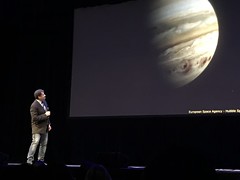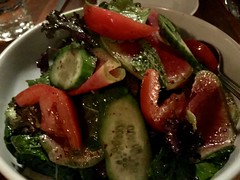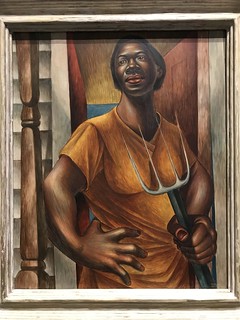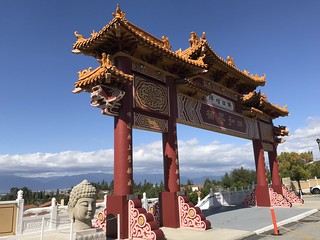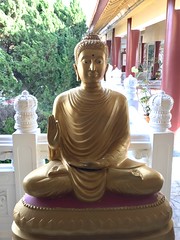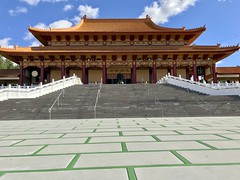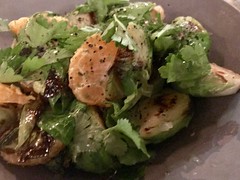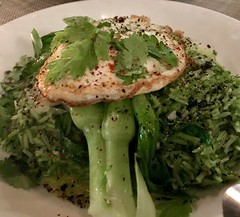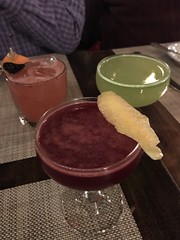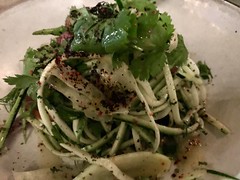I picked up The Forgiven by Lawrence Osborne because I was looking for books about Morocco in anticipation of our upcoming trip, and this was highly recommended. It stood out from some of the other obvious choices because it wasn’t set in Tangier. Now that I’ve finished it, I have mixed feelings about it, and I don’t think it was a great choice for getting excited about a trip to Morocco. Most of the novel takes place in a renovated ksour (fortified Berber village) on the edge of the Sahara, at a party thrown by a decadent gay couple. The premise is interesting enough: while driving to the party, a British couple accidentally hits and kills a young Berber fossil seller, then toss his corpse in the back of their car and head on their way. The book is most interesting when we get flashbacks of the young man’s life, and in the ultimate encounter between the British doctor and the father of the young man he killed, and in the way it makes you ponder the morality of the characters’ actions. My biggest problem was that I disliked all of the main characters, and had little investment in what became of them, other than curiosity to see how the plot unfolded. And the general representation of Europeans and Americans visiting Morocco was so grotesquely decadent and imperialist that it made me cringe in embarrassment as a soon-to-be tourist. But the good parts (the ones away from the party) and the unexpected ending, worthy of an O. Henry story, made me not regret finishing this harsh morality play.
Tuesday, March 26, 2019
Monday, March 25, 2019
Neil deGrasse Tyson: Cosmic Collisions
This evening was my first time seeing rock-star astrophysicist Neil deGrasse Tyson, and I have to say, he held forth on his topic of the evening, "Cosmic Collisions", for over two hours straight and the time flew by. Even the children were completely engaged. I know because I was sitting next to some. Of course talking about the myriad ways that objects in space can collide gives ample opportunity for cool lessons and for videos with eye-popping sights and thunderous sounds. (Yes, I know, there is no sound in space. But there is sound when large meteors land on earth and shatter windows in buildings.) And in between the explosions, I actually learned a few things I didn't know, such as why sometimes several craters are all lined up (broken up meteor pieces hitting the same point at different times as the planet spins), or why the craters on the Moon are all perfectly round even though probably caused by an angled impact (caused by explosion on impact, whose blast radius is equidistant in all directions). Fun stuff!
Sunday, March 24, 2019
Meet Mayor Pete
Wow, I am seriously impressed with this up-and-coming presidential candidate, Pete Buttigieg. He is seriously smart, has a lot of great ideas, and expresses them in a very positive way that I think could rise above the divisiveness. If you haven’t heard of him yet, he’s the mayor of South Bend, Indiana (the home of Notre Dame). He’s progressive and openly gay, but in addition to speaking openly about his husband, he speaks openly about his Christian faith and about his military service in Afghanistan. In a very red state, in a city in the manufacturing belt, this guy was elected to his second term as mayor with over 80% of the vote. I think he has the potential to appeal broadly and to lead the country in a way that won’t leave 49% of us steaming in resentment. (Yes, his name is a bit of a tongue-twister. It’s pronounced BOOT-edge-edge.) This CNN town hall with him at SXSW is a good introduction:
Saturday, March 23, 2019
STAGE: Lackawanna Blues
Ruben Santiago-Hudson’s one-man (plus guitarist) show Lackawanna Blues is a remarkable performance, an engaging memoir in which he recreates the scenes and characters of his growing up in an extraordinary boardinghouse in 1950s upstate New York. With an absent father and a mother barely in the picture, Ruben was effectively raised by “Nanny”, an indomitable woman who ran several boarding houses and a car service, who played angel of mercy to countless humans and animals in need, and who seemed to run her own 1950s “underground railroad” from her native Virginia to Lackwanna when the metal of the rust belt was gleaming new and industrial jobs were plentiful. Nanny is the heart and soul of the play, but given definition by the great variety of characters who populated the boardinghouse, and their stories. With minimal sets and props, just with changes in voice and posture, Santiago-Hudson brings to life a kaleidoscope of characters on stage, painting a vivid picture of how these people were, and how they appeared in the eyes of a young boy. Through most of this, Chris Thomas King sits on a stool on the side, playing out the blues music of Bill Sims Jr., providing the soundtrack for this story as well as the occasional sound effect. Santiago-Hudson’s delivery is subtly and deftly married to the music, mostly natural speech but sometimes falling into rhythmic patter, and occasionally punctuated by a harmonica solo, but at every point authentic blues. By the end of the play, you felt like Nanny’s boardinghouse was a kind of family, and you’d just got to meet them all. This point was brought home by a gallery of actual photographs, a family album of sorts, on display in the lobby, which so many of us in the audience lingered after the show, delighted to see photos of people we felt like we’d gotten to know.
Labels:
stage
Saturday, March 16, 2019
FILM: Giant Little Ones
Just when you thought there was nothing new to be done with coming out stories, Giant Little Ones takes the genre to Gen Z, with its putative openness to sexual fluidity tested against the societal need to categorize and label people, and the perennial emotional gauntlet that is high school. While not nearly as sunny and tidy as last year’s Love Simon, it drove its fresh and unpredictable plot through more complex and at times darker terrain to an emotionally satisfying ending, provided you’re willing to let the characters love without labels (as the tagline of the film suggests). The film benefits from some sensitive and authentic performances from young actors Josh Wiggins as the main character Franky and Taylor Hickson as Tash, his best friend’s sister, with some playful but sensitive dimension added by Niamh Wilson as Franky’s gender-non-conforming friend Mouse. Writer-director Keith Behrman shows a sensitivity to high school dynamics and the many ways of not fitting in that called to mind John Hughes films like Pretty in Pink.
Friday, March 15, 2019
FOOD: Bowery Bungalow
The Bowery Bungalow is a nice space in a converted bungalow just behind Sunset Junction, serving modern Middle Eastern cuisine. We were welcomed with a cumin-rich lentil soup amuse bouche and glasses of sangria. We started with a fatoush salad, a heap of interesting greens with pieces of tomato, cucumber, and mandolin-sliced watermelon radishes in a sumac vinaigrette. Charred broccolini came in a sweet-tangy Aleppo pepper sauce with dates and almonds. Fried cauliflower was dusted in dukkah and covered in rich tahini sauce. Beef tenderloin “shishkatori” kebabs were well seasoned and grilled to perfection. Turmeric chicken fried rice was a nice blend of flavors and textures with roasted chick peas, almonds, and golden raisins. Middle Eastern style coffee was poured from an ornate pitcher into an equally ornate demitasse. And a chocolate pot de crème came with fresh whipped cream and a fantastically light halveh (sesame confection). (See pics here.)
Labels:
food
ART: Charles White Retrospective at LACMA
Today at LACMA I became acquainted with an extraordinary artist I had not known before. Charles White (1918-1979)
was an African-American artist who grew up in Chicago during the Depression, but also lived in New Orleans, New York, Mexico City, and ultimately Los Angeles. He worked in a variety of paintings, murals, graphic print works, woodcut, with influences ranging from WPA projects to Diego Rivera and Soviet social realism, all filtered through his own distinctive African-American experience. His subjects are always human figures, generally very expressive, evocative, soulful. A woman with a pitchfork stands on her porch in “Our Land”, like a black American Gothic, a look of satisfaction in her hard work. A man and woman show utter hopelessness in “There Were No Crops This Year”. White served in WWII, and a couple of the works showed the complex feelings of black soldiers, proud to serve their country but uncertain whether their country would return their respect. Many works show iconic figures like Harriet Tubman and Frederick Douglass, often with imagery of Old Testament prophets, pointing the way to the promised land. I lingered over so many of his works, captivated by their emotional power and their visual dynamism. Interestingly, before I entering this exhibit, I visited the sculpture garden to see some of my favorite works by Rodin, and with those works fresh in mind I saw many similarities with White’s paintings: powerful evocative human figures, dramatically oversized hands, the same ennobled despair and resolution chiseled into faces. I don’t know if White would have ever seen Rodin’s Burghers of Calais, but his take on the 20th century African-American experience would have an interesting dialog with those 14th century French victims of the Hundred Years War sculpted by Rodin. (See complete pics from my visit to LACMA.)
Labels:
art
FOOD: Ramen Tatsunoya comes to Silver Lake
From the Hakata district of the port city of Fukuoka on the nothern side of the island of Kyushu in Japan comes a particular style of ramen called tonkotsu ramen. It is made from boiling pork bones for hours on end to make a rich umami-laden broth, and adding thin noodles traditionally firm in the center. Tatsunoya Ramen comes from Fukuoka, with its first US outpost being a spot in Old Pasadena which is always mobbed. Just recently, they have added a Silver Lake location, and the secret is not quite out yet, as you can still get in without waiting. I can attest that the broth is rich, the noodles are al dente, and with some slices of pork belly, a bit of green onion, and kombu added, it is a richly satisfying and flavorful bowl. Close your eyes and you could be in Fukuoka. Open your eyes, and you're enjoying this delicious ramen on a lovely sunny terrace looking across Sunset Blvd to the murals of Micheltorena Elementary.
Labels:
food
Saturday, March 09, 2019
STAGE: Cinderella
I had seen Matthew Bourne's Cinderella twenty years ago when it opened, and was delighted to see it again. The choreography is riveting, a perfect match to the jaunty and evocative Prokofiev music. The dancers seemed at times to defy gravity and physiology, sometimes floating in air, sometimes bending at odd angles, other times bending fluidly as if they were a liquid being poured from one space to another. All of it served to wordlessly convey the characters in the story, from the creepy unctuousness of the step-brothers and the imperious evil of the step-mother, to the reticence turned blossoming of Cinderella and the desperation of the pilot after he’s lost her. The Cinderella story is of course well known, but it has been creatively re-set into London 1940, where Cinderella (who has step-brothers as well as step-sisters) meets a handsome RAF pilot and then they get separated in the confusion of the Blitz. The staging is fantastic, beautifully conjuring WWII London, complete with the sounds of bombers flying overhead and air raid sirens. The Act II ballroom scene is a marvelous showcase of dancing followed by a beautiful pas de deux between Cinderella and the pilot. The “angel” (the fairy godfather?) has some breathtaking moves. What a feast for the eyes and ears.
Friday, March 08, 2019
X'tiosu and Hsi Lai Temple: Lunch on the border of Lebanon and Oaxaca, afternoon in Taiwan
For lunch, I traveled to the border of Lebanon and Oaxaca (actually Boyle Heights), where a new restaurant called X'tiosu Kitchen has popped up recently. A couple of brothers came from Oaxaca, cut their cooking chops in Lebanese restaurants in Santa Monica, and now are fusing those skills with their native flavors to create "comida libanesa estilo oaxaqueña". That turns out to be a chicken shawarma taco, with a double layer of corn tortillas to give the heft of a pita, grilled chicken, a bright pickled turnip, and the rich tahini sauce dancing with a hot smoky salsa made from chile de arbol and guajillo peppers. That means that their tabbouleh blends lots of fresh parsley and tomato with nopalitos (cactus) instead of bulgur. It means hummus is whipped from black beans instead of chick peas, and graced with olive oil, paprika, and cumin. It means you're lucky to live in Los Angeles, where magic like this can happen.
After lunch, I went to Taiwan for the afternoon (actually Hacienda Heights). The spectacular Fo Guang Shan Hsi Lai Temple is built dramatically into a hillside, so that you ascend through a series of temple structures, symbolic of the Buddhist journey of enlightenment. From the height of the main temple, looking out over the golden rooftops of the other structures, and further out over a brilliant blue sky with dramatic clouds, I felt like I could have been in Tibet if not Taiwan. I wandered the gardens and grounds filled with fantastic images of buddhas, boddhisatvas, and other revered figures. I saw monks in their robes, and watched people praying. I lit some incense as I saw others doing. Several helpful people offered to answer any questions. I stepped inside the main temple and marveled at literally thousands of buddhas. On the opposite wall facing you as you enter are three gigantic buddhas. As your eyes adjust, you realize that the columns are made up of stacked niches, about 2-foot square, each with its own buddha figure in it. Then you realize that the walls between the columns are filled with even smaller niches, each with buddhas in them, and each with a unique name. The whole experience was fantastically serene, which I suppose is the goal. I am so lucky to live in LA, and have the world in my city!
After lunch, I went to Taiwan for the afternoon (actually Hacienda Heights). The spectacular Fo Guang Shan Hsi Lai Temple is built dramatically into a hillside, so that you ascend through a series of temple structures, symbolic of the Buddhist journey of enlightenment. From the height of the main temple, looking out over the golden rooftops of the other structures, and further out over a brilliant blue sky with dramatic clouds, I felt like I could have been in Tibet if not Taiwan. I wandered the gardens and grounds filled with fantastic images of buddhas, boddhisatvas, and other revered figures. I saw monks in their robes, and watched people praying. I lit some incense as I saw others doing. Several helpful people offered to answer any questions. I stepped inside the main temple and marveled at literally thousands of buddhas. On the opposite wall facing you as you enter are three gigantic buddhas. As your eyes adjust, you realize that the columns are made up of stacked niches, about 2-foot square, each with its own buddha figure in it. Then you realize that the walls between the columns are filled with even smaller niches, each with buddhas in them, and each with a unique name. The whole experience was fantastically serene, which I suppose is the goal. I am so lucky to live in LA, and have the world in my city!
Thursday, March 07, 2019
FOOD: Farewell to PYT
The inevitable downside of LA’s hot dynamic restaurant scene is that restaurants, even good ones, will close. On Thursday, we ate a farewell meal on the last night of service at PYT, Chef Josef Centeno’s restaurant that lead the charge on the wave of vegetable-forward cuisine in LA. When Jonathan Gold compiled a list of the top 10 dishes of 2016, nearly half of them were vegetables, and one of them was Centeno’s roasted turnip, roasted for hours in a salt casing wrapped in a hoja santa leaf. I never got to try the turnip, as they had moved on to other delicious vegetables in their changing seasonal menu. I was hoping they might have brought it back for their last hurrah, but no luck. What we enjoyed instead was very fine consolation. We started an amuse bouche of oro blanco segments in a puddle of charred shallot oil, sprinkled with dukkah, singing on our tongues with various notes of sweet, acid, and umami. Here, even the cocktails showcase vegetables. Our table sampled the Beet It (beet, bourbon, kombucha, lemon, sugar), the Cara Cara Crush (rye whiskey, raspberry, orange juice, ginger), and a Celery Margarita (tequila, celery, lime, agave). We began with a kanpachi crudo (the only animal protein in our meal) in a bright carrot-turmeric aguachile that I wanted to soak up every drop of. For salads, we had a zucchini “noodle” slaw with chimichurri spice, pomegranate, and lemon, and roasted baby beets with chicory greens in a buttermilk-oregano vinaigrette that added a novel tang to the sweet beets. Then came the main part of the meal – all vegetables. Grilled cauliflower and romesco were made earthier by a truffle cream, punctuated by yuzu zest. Charred Brussels sprouts were bathed in brown butter vinaigrette and coriander leaves, with a sweet acid punch from satsuma mandarin segments. Green piri-piri rice, its herbaceousness reinforced with fresh herbs, came with bok choy and an over-easy egg for richness. And a crispy eggplant was battered in cornmeal (gluten-free!) and mozzarella, served in a tangy-sweet tomato-plum sauce. Anyone who thinks you can’t make a full hearty meal of vegetables hasn’t eaten here. For dessert, we enjoyed a rich thick peanut budino in a salty caramel cream with candied pepitas and coconut.
We’re sad that that would be our last meal at this innovative and delicious venue, but are glad for the impact it has had on LA’s food scene. Chef Centeno still has at least three other restaurants within a stone’s throw of this one (someday perhaps the corner of 4th and Main St will be named Josef Centeno Square), and he has said that his best vegetable-forward dishes may migrate to Orsa & Winston, his more upscale tasting menu restaurant. The chef said the closure was not due to the business going down, but to getting a great offer on the space. Rumors are that the people behind Lock and Key (a Koreatown speakeasy) and Nightshade (new pan-Asian spot in the Arts District) plan to open something here. The dynamism of our food scene means things keep changing, so we’ll be eager to see what comes next.
We’re sad that that would be our last meal at this innovative and delicious venue, but are glad for the impact it has had on LA’s food scene. Chef Centeno still has at least three other restaurants within a stone’s throw of this one (someday perhaps the corner of 4th and Main St will be named Josef Centeno Square), and he has said that his best vegetable-forward dishes may migrate to Orsa & Winston, his more upscale tasting menu restaurant. The chef said the closure was not due to the business going down, but to getting a great offer on the space. Rumors are that the people behind Lock and Key (a Koreatown speakeasy) and Nightshade (new pan-Asian spot in the Arts District) plan to open something here. The dynamism of our food scene means things keep changing, so we’ll be eager to see what comes next.
Labels:
food
Tuesday, March 05, 2019
FILM: Roma
I had heard a broad range of reactions from friends who’d seen Roma, from “beautiful” to “like watching paint dry”, and I think it depends what you want from a film. If you’re looking for a clever plot, laughs, or great action, you’ll find Roma very unsatisfying. But if you appreciate a film that shows you a slice of life in a way that really makes you think, or if you appreciate a film that genuinely evokes a time, a place, a mood, then you’ll find much to appreciate. And if you’re the sort of film fan who loves the art of film -- someone who loved Linklater’s Boyhood, who reveled in the opening scene of Altman’s The Player, who can discourse on the technique of Orson Welles and Alfred Hitchcock -- you’ll be loving this film from its opening scene: water repeatedly surging and receding across some unlocatable pavement, eventually coming to stillness reflecting an opening onto a piece of sky in which an airplane slowly flies across. One viewer’s masterpiece is another viewer’s paint drying. Me, I appreciated watching the paint. Some of the scenes were almost painterly, like “Pageant of the Masters” in their composition, and yet completely natural. I found everything worked to create a complex impression. There was the sense of childhood, its innocence, and the nostalgia of its recollection for the children in this family, as you watch them being happy and oblivious as serious things happen to the adults they love and feel close to. You can sense the director being reflective of his own childhood experiences in that time and place. There was the ambiguous relationship of the nanny to the family, some fuzzy place between employee-servant and beloved family member, both attached and detached. There was the comfort of this home and this neighborhood, with social and political unrest just scraping the side of the car occasionally as they ride through their lives. And it was beautiful.
Saturday, March 02, 2019
OPERA: The Clemency of Titus
We thoroughly enjoyed the soprano-fest at LA Opera’s The Clemency of Titus. It was the last opera Mozart wrote, and it was scored not only for two sopranos for the female roles, but a soprano castrato and a soprano en travesti (cross-dressing) playing two male roles. In modern times, since castrati are in short supply, those two “trouser roles” are sung by mezzo-sopranos. With soldierly costumes and fake beards, they were quite effective and affecting. There were some lovely duets between the “men” and the women, and one between the two “men”. The orchestration included harpsichord and some period instruments called basset clarinet and basset horn, each of which had a featured “duet” with a soprano. The voices were all strong. Elizabeth DeShong, demonstrated great range and emotion as Sesto, a young Roman nobleman who is goaded by the object of his love to turn against his dear friend. Guanqun Yu was vibrant and beguiling as Vitellia, the conniving beauty who manipulates Sesto to evil ends. Russell Thomas’ rich tenor voice rang true as the virtuous Emperor Titus who, Camelot-style, who is betrayed both personally and in his ideals by those he most trusts and loves. The opera was commissioned for the occasion of the coronation of King Leopold II of Bohemia in 1791, mindful of the terrors in France, wanting to encourage the new Holy Roman Emperor with themes of noble and benevolent leadership. Some details of the historical Titus, who was a magnanimous emperor, are shown in the opera: when subjects give him gold to build a great statue in tribute to him, he requests that the riches instead be diverted to needy citizens in his realm recently affected by natural disaster. A number of themes and notes in the opera had unexpected relevance in contrast with our own current experience of national leadership. As we’ve come to expect to be spoiled by with LA Opera, not only did we get top notch singers, orchestra, and chorus, but also gorgeous set design and costumes, evoking the grandeur of a fantasy of Imperial Rome, in splendor and opulence, and later in flames and ruin. (Fun fact: La Clemenza di Tito premiered in 1791 at the Estates Theatre in Prague, which I’ve had the pleasure to visit, and which is the only theatre still standing where Mozart performed.)
Labels:
opera
Subscribe to:
Comments (Atom)

